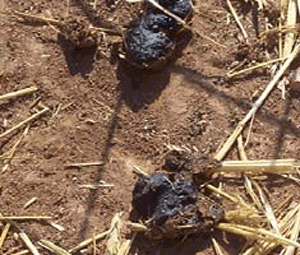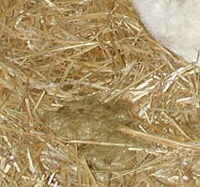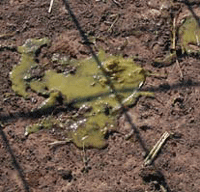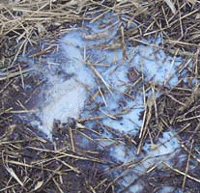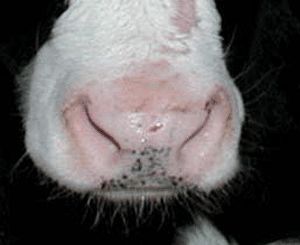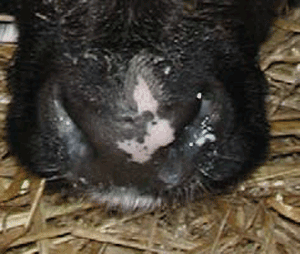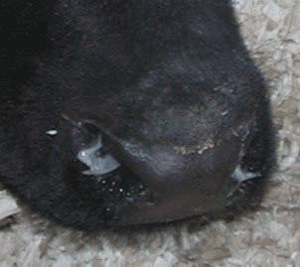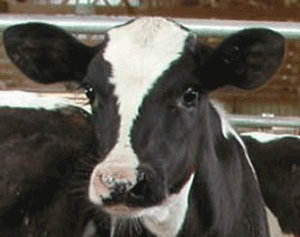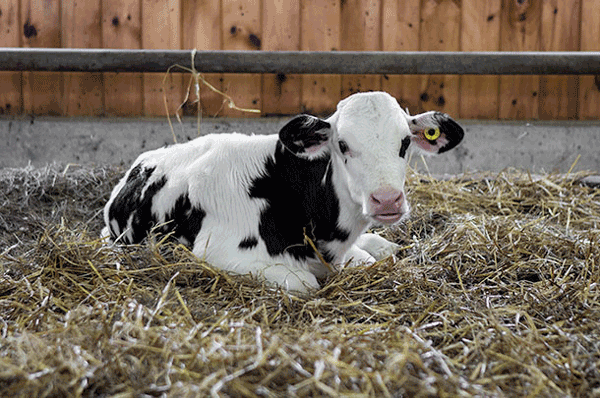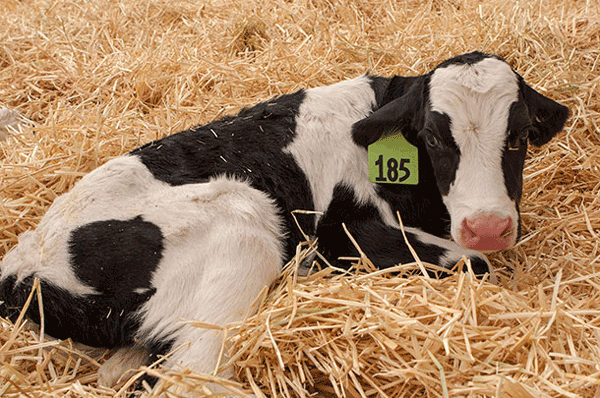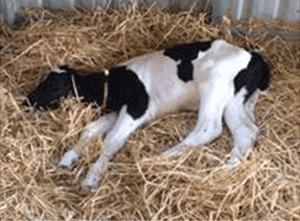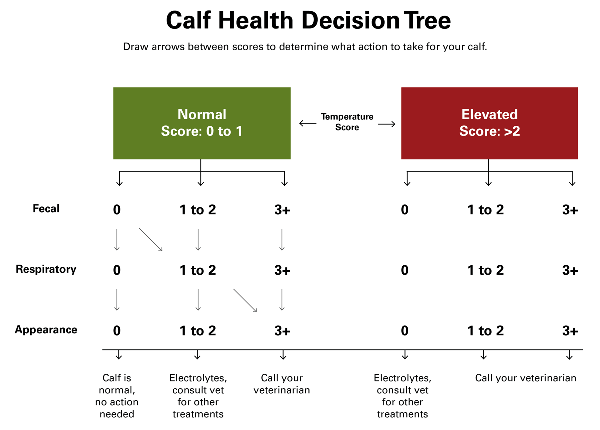Caring for your calf is fun and rewarding, but it can sometimes be stressful. Just like us, calves can get sick. Many illnesses that calves develop can be prevented by good observation and care. Some illnesses, however, are unavoidable and require treatment by a veterinarian. This guide will help you learn how to identify sick calves before they show any symptoms of disease, and how to manage your calf and its environment to prevent or reduce illness.
Common Calf Issues
The key to successful calf rearing is providing adequate immunity through good quality colostrum.
Colostrum, the first milk given by a cow, is filled with immune factors such as immunoglobulins and proteins. Ideally, colostrum should be given as soon as possible after birth. Calves should receive at least 1 gallon of good quality colostrum within 24 hours of birth before their gut begins to close up and the calves can no longer absorb the large immunoglobulins, such as IgG.
If you purchased a calf from somewhere other than directly from a producer and you do not know the colostrum status of your calf, you can test their blood for IgG concentration. The IgG Check Test Kit (PortaCheck, Inc.) is an at-home test kit used to determine if a calf received proper passive immunity from another source. To pass the IgG test, calves should have at least 1,000 mg/dL (or 10 mg/mL) of IgG. A calf that does not pass this test should receive colostrum supplements to boost its immunity. These supplements must be administered in the first 24 hours after birth, and will not be effective if a calf is more than one day old. Vaccinating your calf and keeping its housing area clean, dry, and well ventilated will also help your calf thrive. You should consult with your veterinarian to develop a plan for vaccinating your calf.
The leading causes of sickness and death in young calves are diarrhea, which is commonly called “scours,” and respiratory or lung infections. Scours and respiratory infections are caused by bacterial, viral, and/or parasitic infections, and are often related to germs (pathogens) commonly found in the calves’ environment. Dehydration is the actual cause of death in most calves that develop severe scours. If we can treat the dehydration, the calf is likely to recover. Table 1 shows the ages that you may see common germs that cause scours. With some germs, such as coronavirus, calves may show signs of diarrhea and respiratory illness. With bovine respiratory diseases (BRD), proper vaccinations and a clean environment with good ventilation can drastically reduce death and disease caused by BRD. See Figure 1 for a graphical representation of Table 1.
Treating Sick Calves
There are some things we can do on the farm to help sick calves get better. However, calves that have severe signs of illness or moderate symptoms that do not improve within two days or more need the attention of a veterinarian. Often, by the time our calves have symptoms, we are behind with treatment. Therefore, you should not hesitate to contact your veterinarian to discuss your calf’s symptoms and possible treatment. Treating calves with antibiotics or anti-inflammatory drugs must be done under the supervision of a veterinarian. Some germs, such as Salmonella and Cryptosporidium, are zoonotic, which means that they can infect humans as well. Thus, it is very important to follow basic biosecurity protocols such as:
- Always wearing disposable gloves when handling sick animals.
- Washing your hands with soap and warm water before and after working around sick animals.
- Avoiding contact with your eyes, mouth, and face.
- Wearing clothing that is easily removable when leaving the pen or barn.
- Wearing shoes or boots with rubber soles that can be easily sanitized with a disinfectant after leaving the animals’ area. You should clean your hands, shoes, and all equipment in between visits to individual animals and when you are finished.
Oral electrolyte solutions can help calves rehydrate and are the first step toward recovery from scours. Because all oral electrolyte solutions are not the same, it is important to know your veterinarian’s recommendation so that you can have it on hand when needed. Typical electrolyte solutions are given to calves over a period of two to four days to help relieve symptoms of scours. We recommend giving calves electrolytes one time each day, in between feedings if the calf is able to suckle and stand. You may need to reduce the amount of milk fed at each feeding to encourage calves to drink the electrolytes.
Completely suspending milk feeding during this time can cause undernutrition. One option is to feed the calf a regular amount of milk at the a.m. feeding, offer electrolytes mid-day, and then half of the milk feeding in the p.m. If the treatment with electrolytes does not resolve the scours within two to three days, contact your veterinarian. With respiratory illness, prevention is key. Providing dry (but not dusty), well-ventilated housing is critical to prevent respiratory illness. Most medications used to treat respiratory symptoms should be given by the recommendation of your veterinarian. If you notice excessive, chronic coughing, or abnormal discharge from the calf’s eyes or nose, you should contact your veterinarian.
During this time, it is important that you observe and record the health of your calf. The Health Scores chart can help you determine if your calf is normal, moderately sick, or severely sick. Keeping track of scores for fecal consistency, respiratory issues, and general appearance, as well as rectal temperatures, will help you identify sick calves as early as possible. Download the Health Scores Record (PDF, 61 KB) and use the Calf Health Decision Tree to help you track the health of your calf.
Other Calf Care Tips
- When mixing milk replacer, it is best to weigh the powder because the scoops in the bags or boxes are often inaccurate. Weighing the powder before mixing will ensure a consistent delivery of nutrition to the calf. The temperature of the water is also important. It is best to follow the instructions on the bag to be sure that the powder dissolves appropriately.
- Calves should be hungry and drink or suckle energetically. If your calf does not show interest in milk or does not finish the bottle relatively quickly, you should evaluate it by using the health chart and taking its temperature.
- Calves and cows are herd animals that like to live “with friends.” It is important to limit a calf’s contact with older animals until the calf has improved their immune system (around 14 days of age).
- Calves always need clean, fresh water. This is particularly important when the weather becomes warmer.
- Calves should start “nosing around” in starter feed around three to five days of age. Weaning should start when the calves are consistently consuming adequate starter feed each day. A gradual weaning process is ideal for calves. Cut the milk feedings by half (feed only once per day, or feed one-half amount at each feeding) when they are consuming 3 to 5 lb of starter feed per day. Discontinue milk feeding when they reach 5 to 7 lb of starter feed per day, which is typically about a week later.
Health Scores
| Parameter | Score | |||
|---|---|---|---|---|
| 0 (normal) | 1 | 2 | 3 (severe) | |
| Fecal Consistency Score | Normal, firm, calf rear is clean (Figure 2) | Semi-formed, “peanut butter” consistency, calf rear is clean (Figure 3) | Loose, “pancake batter,” calf rear has loose manure (Figure 4) | Watery, calf rear is wet, matted, dirty with manure (Figure 5) |
| Respiratory Score | Normal breathing; no cough; no nasal discharge (Figure 6) | Normal breathing; occasional cough; small discharge (single nostril, see Figure 7) | Repeated cough; labored breathing; nasal discharge (both nostrils, clear or cloudy; see Figure 8) | Constant cough; labored, rapid breathing; excessive mucous (cloudy, colored) discharge (Figure 9) |
| Appearance | Alert, active, ears and head held up, eyes normal (Figure 10) | Less responsive, droopy ears; stands up but slow (Figure 11) | Depressed, lethargic, head down, ears drooping (Figure 12) | Not responsive, will not stand, eyes dull, head and ears down (Figure 13) |
| Rectal Temp | 100°F to 100.9°F | 101°F to 101.9°F | 102°F to 102.9°F | Over 103°F |
Images adapted from:
Dillane P., Krump L., Kennedy E., Sayers R.G., Sayers G.P. 2020. “Determining the Predictive Capability of a Clinical Assessment Scoring Chart to Differentiate Severity of the Clinical Consequences of Neonatal Calf Diarrhea Relative to Gold-Standard Blood Gas Analysis.” PLoS ONE 15(4): e0230708.
Hoskins, A. 2018, March 1. “7 Signs Calves are Headed Down a Bad Health Path.” Progressive Dairy. Accessed May 2, 2022.
McGuirk, S.M. 2022. “Assessment, Scoring, and Disease Management of Dairy Calves.” Accessed May 2, 2022.
University of Wisconsin-Madison, School of Veterinary Medicine. 2015. “Calf Health Scoring Chart.” Accessed May 2, 2022.
Calf Health Decision Tree: Step-by-Step
Decisions begin with taking the calf’s temperature.
If the temperature score is 0 or 1, and the fecal, respiratory, and appearance scores are 0, the calf is normal and no action is needed.
If the temperature score is 0 or 1, and the scores for fecal, respiratory, and appearance scores are either 1 or 2, the calf needs electrolytes and you should consult with your veterinarian about other treatments.
If the temperature score is 0 or 1, and the scores for fecal are 3+, respiratory 3+, and appearance scores are 3+, you should call your veterinarian.
If the temperature score is 0 or 1, and the scores for fecal are 0, respiratory 1 or 2, and appearance scores are 3+, you should call your veterinarian.
If the temperature score is elevated at 2 or 3, and the scores for fecal, respiratory, and appearance are 0, the calf needs electrolytes and you should consult with your veterinarian about other treatments.
If the temperature score is elevated at 2 or 3, and the scores for fecal, respiratory, and appearance are 1 or 2, you should call your veterinarian.
If the temperature score is elevated at 2 or 3, and the scores for fecal, respiratory, and appearance are all 3+, you should call your veterinarian.
See Figure 14 for a graphical representation of this process.
Publication date: June 14, 2022
AG-918
N.C. Cooperative Extension prohibits discrimination and harassment regardless of age, color, disability, family and marital status, gender identity, national origin, political beliefs, race, religion, sex (including pregnancy), sexual orientation and veteran status.


